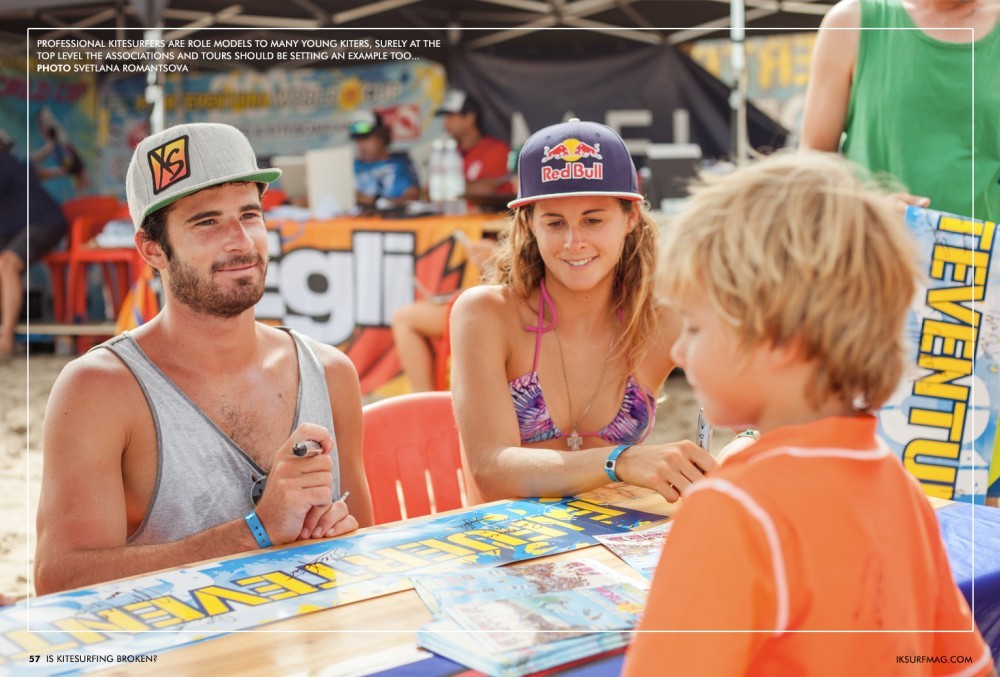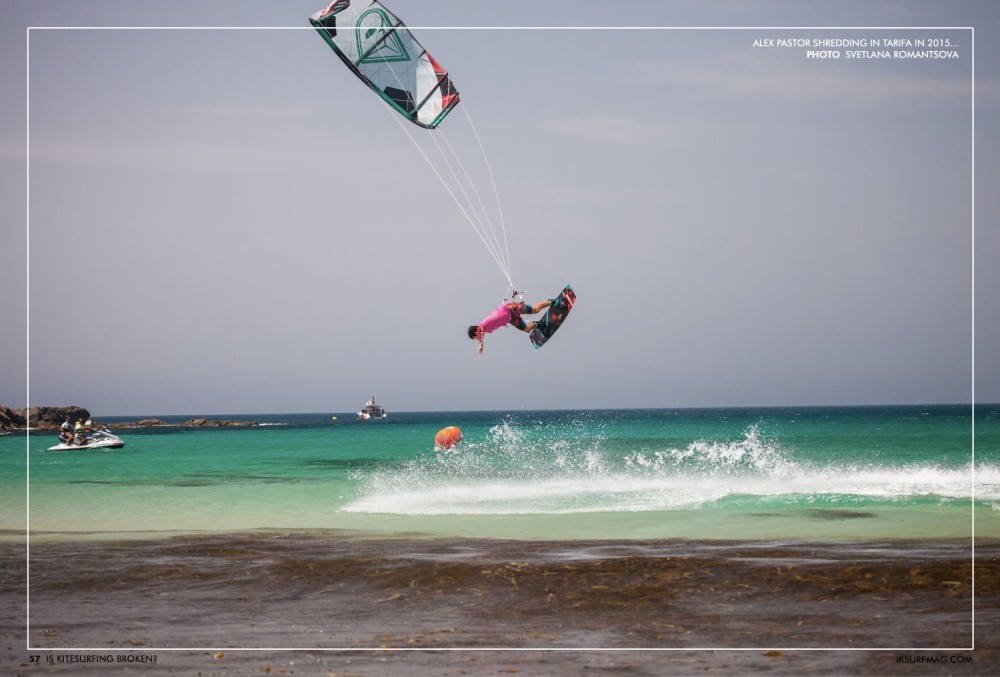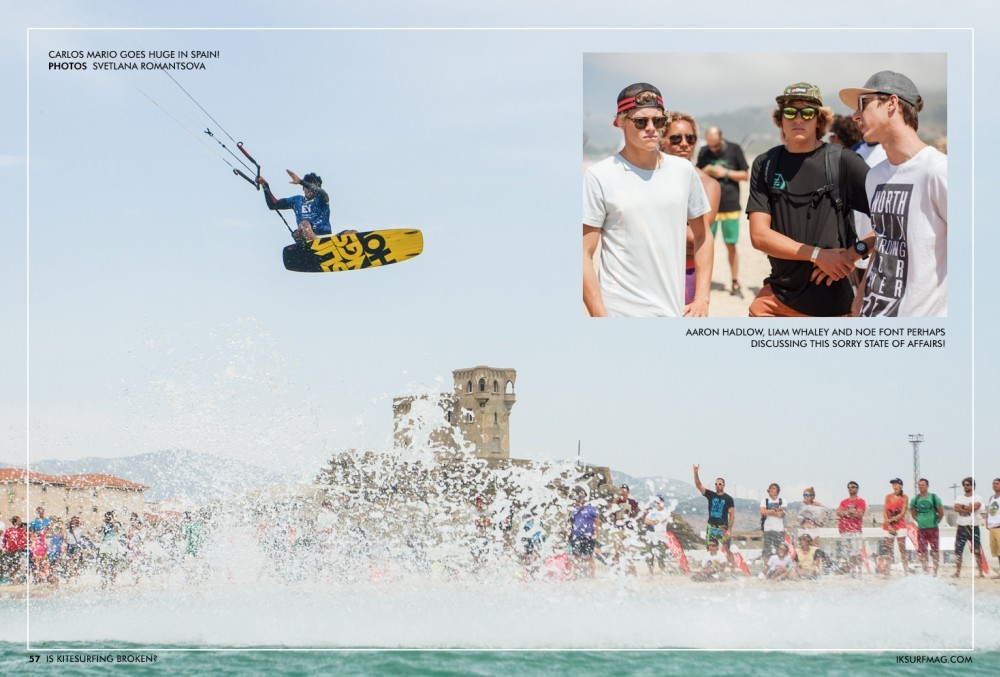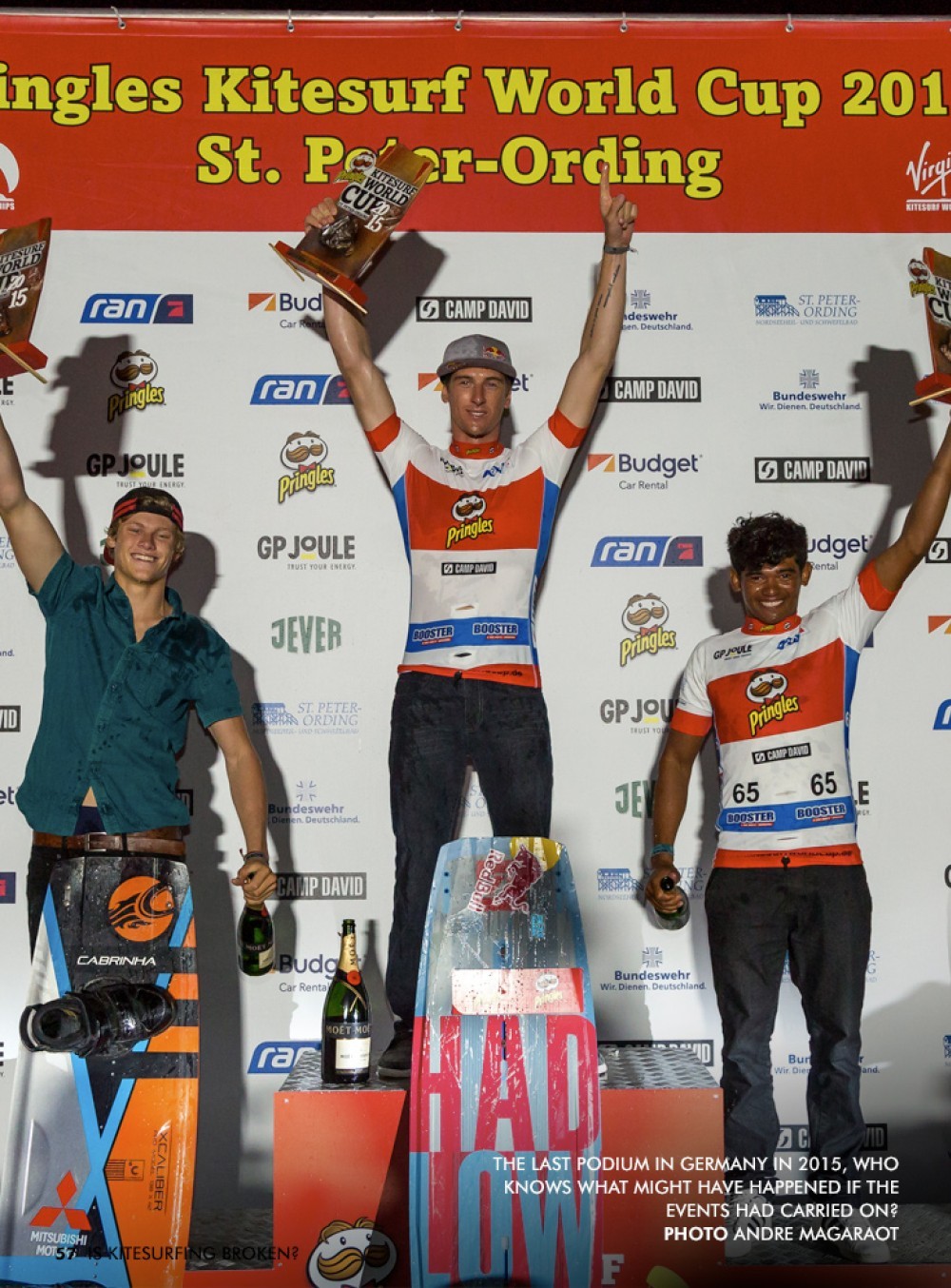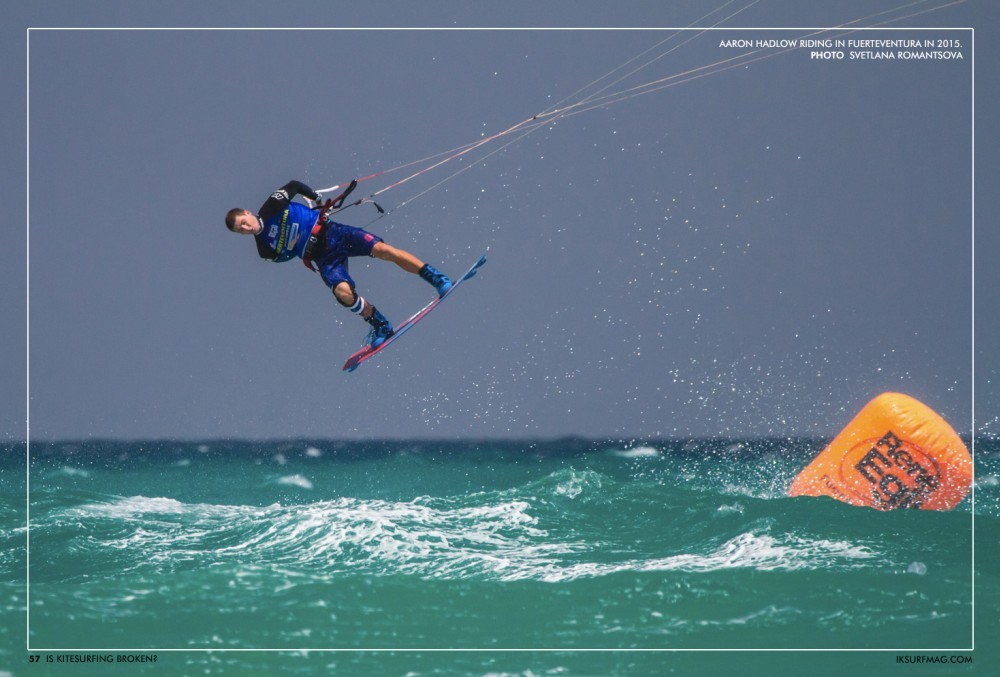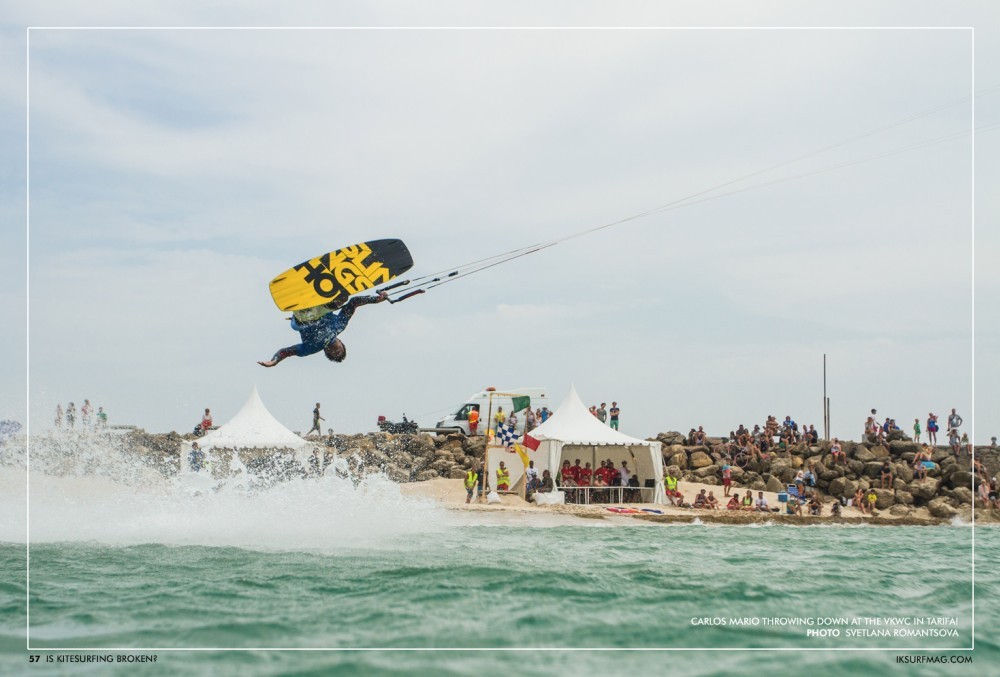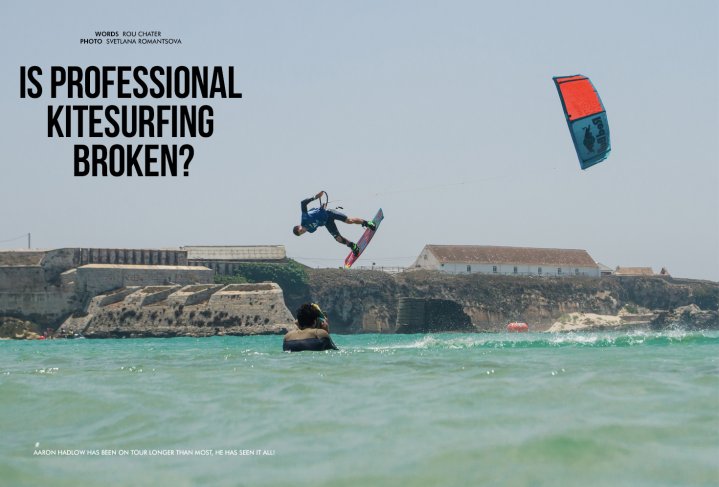
Is Professional Kitesurfing Broken?
Issue 57 / Sun 12th Jun, 2016
There is a war being waged between various parties at the very top of our sport, it’s a struggle for ownership, control and World Title rights, and it's high time it stopped. Rou Chater gives you all the information you need to know and explains the myriad of acronyms our sport is now littered with.
Rou Chater investigates the damaging battle going on at the top of our sport for control of kitesurfing as a whole, the world tour and everything that goes with it. It’s a confusing mess of different parties with different agendas, this article has everything you need to know so you can tell your GKA’s from your IKA’s and your WKT’s from your WKL’s!
I’ve been lucky enough to be involved with this fantastic pastime since the very beginning. I was a totally addicted, obsessive and compulsive kitesurfer just like you. I still am to this day. In a personal capacity I have enjoyed the sport immensely, and in a professional one, it has afforded me the rare opportunity to build a business, create jobs and hopefully entertain you all with the content we produce.
However, there has been a dark cloud looming over our sport for some time now, and I think the time has come when we just can’t sit back and watch it all fall apart anymore.
I wrote an article in 2013 entitled Falling In Love With The PKRA Again; you can read it HERE if you like.
Now before you switch off at the mention of the PKRA, flat peak hats, oversized headphones and freestyle, stick with me, because this is an important issue. In that article, I sang the praises of the new format of the Professional Kiteboard Riders Association World Tour.
Freestyle kitesurfing at the time was suffering from a total disconnection with the sport we all love. The level had progressed so far and so fast, a testament to the athletes competing within it. Unless you could spot a Hinterberger 5 in the blink of an eye, or tell the difference between a Front Mobe and a Slim Chance in less time than it takes for Maverick to get into Kelly McGillis’ pants in Top Gun, then you were missing out.
For most of us, kitesurfing is about the feeling of being free on the water, with the wind pulling us along as we glide across the ocean. We get our kicks from boosting airs and braving the elements. Take the lifestyle of an average kitesurfer and what he gets up to on and off the water and compare it to a pro and it is easy to see where the disparity comes from.
In 2012 the World Tour had reached a frenzied peak of bewilderingness for the masses. Anything pretty much went and watching a heat was like watching a 12-year-old with ADHD play Angry Birds; most people had no idea what was going on, aside from the other pros and the judges of course. In 2013 a new format limited the riders to their five best tricks in a heat, with only 12 attempts allowed. Instantly this meant that instead of throwing a trick every few seconds the whole affair was slowed down to a pace that was easier to understand for mere mortals.
In 2012 professional kitesurfing wasn’t broken, but it was struggling somewhat in terms of direction. In 2013, that changed dramatically, the new format favoured the more consistent riders, which instantly meant experience counted for something. The average Joe down the beach could watch a heat and have half a chance of agreeing with the judges on the outcome, and the media partnerships got even better, helping people like me spread the word about the tour to the masses. Suddenly the fan base was growing again and the World Tour was back on the map!
Kitesurfing had taken a long time to get to this level; there was a chequered past featuring the PKRA and the KPWT (Kiteboard Pro World Tour). This led to great moments like Mark Shinn being the undisputed double World Champion in 2002 when he committed to competing on both tours and became the only kitesurfer in history to win two world tours in the same year!
However, it also led to infighting between the two tours with both of them fighting to proclaim the “true” world champion. In the end, the PKRA won the day, and the KPWT died out leaving a true world champion standing on the podium each year. It’s worth mentioning at this moment that the PKRA was originally founded by the rider for the riders. Hence, it's named, the Professional Kiteboard Riders Association.
Founded in 2002 the riders felt the need to create a tour that worked for them, now if you’ve been keeping up with the current affairs at the top echelons of our sport that might sound familiar. Let's fast forward our story a little and get to 2014; the PKRA was running really well, and all the top riders aspired to compete on it. There were some great events all around the world, with a hectic schedule for the riders and lots of amazing action on the water. In the end, Christophe Tack won the men’s Freestyle, and Karolina Winkowksa took the title for the women…
Then in 2015 the tour was plunged into uncertainty, the PKRA was sold to a group of investors who gave it the acronym of the VKWC (Virgin Kitesurfing World Championships). That was where the information ended, among the investors were a large media company, a kiteboarding company and obviously Richard Branson from Virgin, other than that we had nothing. There was a total media blackout for us, the riders and pretty much everyone involved.
Then, as the details about the new tour finally came out, (about a week before the event started) it looked like a smorgasbord of dreams for everyone involved. TV rights were being sold around the globe, increased funding and sponsorship for the riders, more events, live streams that worked, better media relations; it looked set to be the dream tour that kitesurfing deserved.
That was where the dream ended though, as the year wore on we heard tales of non-disclosure agreements that forced those involved, including the riders, to smile and wave, despite cracks appearing in the foundations of what had been a brilliant idea. As tensions rose, a rift formed between the VKWC and the sports governing body, the International Kitesurfing Association, (more about them in a few moments). This came to a head at the Fuerteventura and German events where the IKA and the VKWC were fighting with handbags at five paces like a couple of drunk ladies on a Saturday night.
Members of the IKA told me that the sanctioning and rights fees to run the events and hand out titles hadn’t been paid. Whatever was going on behind closed doors, it was all somewhat hush-hush and with the chance of the VKWC running more events information was sparse from those directly affected by and involved with them, i.e. the riders, and staff. Once it became apparent that the VKWC was over for the year though and wouldn’t be running any more events, the rumours started to fly as the riders felt the shackles of the NDA’s loosening.
Allegedly there were considerable sums of prize money owed to the riders and some of the organisers by the VKWC. I spoke to one of the brands at the time, and they explained that for all the great promises the VKWC made, they delivered on none of them and that the promises were so impressive, that even if one had been delivered, they would have been happy!
It was a sorry end to the year, especially when the winners of the VKWC World Tour were announced by email, with no prize giving or podium! Then to make matters worse the IKA announce two different world champions as their spat with the VKWC grew. This was without a doubt the darkest time for professional kiteboarding in its entire history.
Before we move on to what is happening now, which is arguably worse, and look at the tidal wave of acronyms currently littering the sport, let's dwell on the IKA and look at why they exist and where they come from.
We all know kitesurfers are fast, and to this day we are the fastest craft on the water that fits in the boot of your car! To be officially quick, though, you need to be ratified by the World Speed Sailing Record Council, or WSSRC for short. They have been officiating speed sailing and all the records that are set. To be in their club, the very different breed of kitesurfers had to conform to some standards, jump through some hoops and set up the IKA as a class under the International Sailing Federation or ISAF for short.
If you’ve made it this far you’re doing well, grab a cup of tea and biscuit because things are about to get wild. ISAF then recognised kiteboarding as a class of sailing and began ratifying our World Speed Records as part of the WSSRC. Good news for us a sport, as all of a sudden Robbie Douglas officially became the fastest man on the water for a very brief period on the 3rd of October 2008. Sadly for Robbie, Sebastian Cattelan beat his speed of 49.84knots and became the first sailor in history to break the mythical 50knot barrier. Sebastian would be the first person to describe himself as a kitesurfer, but in order to hold the record, and why wouldn’t you, Sebastian had to be a sailor. Make sense? Good, I hope the tea was hot, and the biscuit was tasty!
From 2008 onwards we continued to break speed records, the IKA continued to develop under the stewardship of Markus Schwendtner among others, and we all just carried on kitesurfing, not really thinking too much of it. Over time, the IKA started sanctioning more events, freestyle, wave and racing, and to most people they had hardly any effect over our actual kitesurfing at the beach.
At a base level the local organisers ran events under the umbrella of whichever tour was operating there, and then the IKA sent a representative along to check everything was fair and above board. They made sure riders were being judged fairly or protests were heard at the race events, that sort of stuff. After all, they had pretty much written the rulebook, so who better to enforce it? Under ISAF rules, they also owned the rights to give away the World Titles too.
None of this came for free, of course, and essentially it was the VKWC and the IKA arguing over the fees the PKRA had previously paid for these privileges that caused the rift. This disagreement ended the 2015 season in a barrage of bickering press releases, two sets of world champions and a fair amount of confusion.
In the midst of this, another association formed, founded at the St Peter-Ording World Cup in Germany, which was not without controversy caused by the infighting between the VKWC and the IKA. The GKA or Global Kitesurfing Association was set up ultimately as a trade association. The brands, who invest so much, felt they needed a representing body, and a voice to mediate between the warring VKWC and IKA.
The brands create all the gear we use, pay the riders we like to watch, and market the sport and have an enormous amount of money invested in it. Like any trade association there are good points and bad points about the GKA, but at its core, they wanted to ease the rift between the VKWC and the IKA and ensure their riders had somewhere to perform. They also wanted to ensure their investment in kitesurfing was protected and had some say in how the sport was governed, which is totally understandable.
The end of 2015 was a miserable place for professional kitesurfing, and websites outside of our sport likened it to a soap opera, which essentially it was, except it wasn’t funny as the joke was firmly on us. I spoke to plenty of riders, and none of them had a good word to say about the VKWC and the way they had conducted the tour that year.
Equally, they were unimpressed by the IKA seemingly ignoring the result of the VKWC and proclaiming two different world champions! Something had to change for 2016, we all knew it, but at the end of the year there were still no real decisions made.
Sadly, change isn’t always a good thing, and professional kitesurfing didn’t go from bad to worse, it went from bad to abysmal seemingly overnight. First up, and unsurprisingly, Virgin pulled out of the VKWC - due to internal differences between the original investors, we are led to believe - and the negative publicity for Virgin can’t have helped either! The VKWC then became the World Kite Tour; they said they were going to be running the World Championship Tour for 2016. This was to be done under a special sanction from ISAF and would not be working with IKA.
In response, the IKA set up the World Kite League, which was going to be an events arm of its business providing riders with a platform to perform. Meanwhile, the French and Portuguese governing bodies decided they’d had enough of all of this and claimed that the IKA had only registered “Formula Kite” as an Olympic discipline with World Sailing and only had Speed and Slalom recognised by ISAF under it’s kitesurfing remit. Before you ask, ISAF changed their name in all of this to World Sailing, just to make it even more confusing!
The French and Portuguese Associations and some other interested parties set up the IFKO, the International Federation of Kitesports Organisations. The basic premise is this: to have a chance of being an Olympic sport, you have to have an International Federation recognised by the International Olympic Committee and SportAccord. The IOC and SportAccord are the highest authorities for sport globally. As ‘everyone’ wants to get on the Olympic gravy train, it makes sense that you have a federation recognised by them. Even people who throw Frisbees have a recognised federation! (It’s the World Flying Disc Federation or WFDF for short, should you be interested.)
The IFKO is a not for profit organisation; they don’t want to rake in huge sums of money to run the sport. Although, as with any association, there are costs involved, so while you can be “not for profit” that doesn’t mean you aren’t running a business. However, I do firmly believe their intentions are good, and in all the correspondence I have had with them they have been very passionate in their responses.
The IFKO fundamentally believes that kitesurfing is not sailing, which I am sure a lot of you can get on board with. The ONLY reason we became associated with sailing in the first place was because a handful of riders needed to be recognised as sailors so they could compete for, and get hold of, the coveted World Speed Sailing Record from the WSSRC, sanctioned by ISAF, now World Sailing. Accordingly, the IFKO have registered every single type of kite sport under their umbrella, aside from Formula Kite, Slalom and Speed, which the IKA had already set up and registered with World Sailing. They want to represent all kite sports and support water, land and snow kiting.
The IKA, on the other hand, run as a limited business, which isn’t untoward, but they do run to make money, charging fees to just about everyone in the sport, including you indirectly. If you have an IKA logo on your kite, then that has been bought and paid for by the brand. There is also a new scheme to charge national associations, schools and even students that is in the process of being implemented. The IKA is here to make money, whether you decide that is right or wrong is up to you.
They argue that kitesurfing is a sailing class, and they are legitimised by World Sailing and the hard work they have put into the sport since 2008, campaigning to get kitesurfing into the Olympics, working to standardise formats and rules and ensuring fair competition along the way. They also have most of the national associations around the globe as members.
One huge difference between the two organisations is that the IKA, in an attempt to keep a grip on the sport, has announced it will ban any rider competing at any event run by a rival organisation proclaiming it to be a world title event. That means if you race or compete at an IFKO event you are then banned from riding at the IKA events. This all seems a bit much when this year there are so few events happening, and the whole show is in disarray. If you are a competitor, you want to compete, it is a simple as that, you also learn more and improve your riding by entering more events.
To me this policy seems to hurt the riders more than anyone, imagine being a good level national rider, who wants to compete on some of the IKA events over the year, but the IFKO are running an event at your local beach, and you can't enter it because the IKA say so. How ridiculous is that? I know a few riders who travelled to the Europe this year to compete in the Youth Event the IFKO were running, only to not enter and fly home because they were told they would then not be able to compete in the IKA events that "might" be coming to the island where they live.
It's an anti-sport, and quite literally anti-competition stance that harms only the riders involved and no one else. Whatever the differences are between the IFKO and the IKA don't use the riders like pawns in a chess game, treat them with respect and allow them to do what they love doing, competing...
The battles between the IFKO and the IKA will no doubt run and run; I’m not placing any bets on the outcome. On the one hand, the IKA has been there for years and has done a huge amount of good work. However, riders and people involved are getting a little tired of all the fees it collects to run its business. The IFKO proclaims not to want to make money and to be here for the good of the sport, but it is so new it is hard to legitimise what it has done for the sport yet, aside from fight with the IKA!
This year we have the IFKO, the WKL (IKA’s events arm) and the WKT (Formerly VKWC) all running events. Also, the GKA is sanctioning some of those events them, but not all of them. The GKA is also running its own wave events throughout the year. If that sounds like a bit of a mess compared to 2014 when we just had the PKRA running the show under the watchful eye of the IKA, then you’d be correct.
It’s not so much a mess as a total clusterf**k of the highest order. How the hell did we get here as a sport? In just two years? It’s unbelievable. However, just when you thought you might drown under a sea of acronyms, here is another one for you. Enter the KRU…
The riders formed the KRU, Kiteboarding Riders United, after they got, somewhat understandably, pi$$ed off by all this. Remember earlier, when I talked about history repeating itself when the PKRA was set up by the riders in 2002?
The KRU have some good ideas, and rightly want to be valued as riders. Something I have said throughout all this is that without the riders you have no event and no tour. They are your prime assets. Treat the athletes properly and the rest will fall into place. The PKRA beat the KPWT because they had the best riders; so being the PKRA champion was seen as the ultimate test of your skill and the ultimate achievement.
However, some of the riders perhaps don’t have the best idea of the sport as a whole, they live in a very particular bubble, travelling the world, doing moves most of us don’t even dream about and riding kites many of us have no interest in flying. On the whole, they are quite young and very different to the makeup of the PKRA back in 2002. There is nothing wrong with that of course, but some of their demands seem a little out of kilter, and consequently they are falling out with some event organisers when their demands aren’t met.
An example of this lack of understanding about the real world of kitesurfing that we all live in would be the failed crowdfunding campaign for their first event in Cabarete. You can check out the crowdfunding page HERE, but they are asking for $100,000 USD to pull it off. Last time I checked, despite it being shared all over Facebook by the pros; they had pulled in just over $2,000 in two weeks.
I don’t think I’ve ever seen a successful crowdfunder for pro kiteboarding ever, charitable ones excluded. A few pro kite movies over the years have requested money because apparently the average Joe wants to pay for some young guys and girls he has no real affinity with to go off and have a nice time, while he goes to work to earn more money to buy more kites and fund their lifestyle. None of them got funded… The rise of crowdfunding attempts within our sport as a whole, is another topic entirely!
Don’t get me wrong; I think the KRU is a great idea; the riders need to stand up for themselves especially after the way they have been treated. However, they also need to be realistic about the sport we are involved in. Kitesurfing is pretty small, although still growing. The World Surfing League, formerly ASP has gone through similar trials and tribulations, and you’ll often hear the pro rider’s say the sport should be held in the same light, with competitions on a similar scale with live feeds and lots of hype and media.
Except that the World Surf League has over 4,660,000 likes on Facebook, with an estimated 15 million surfers worldwide and millions more who simply associate with the lifestyle and have an interest in watching it (read: “bought a Quiksilver T-shirt and spotted the Pipe Masters on their Facebook feed”). It’s a staggering number either way, and it is the reason huge brands like Samsung pay millions to be associated with it.
Kitesurfing, on the other hand, is in an entirely different league, despite what you might think. Last year an estimated 155,000 kites were sold and about 50,000 boards. My conservative estimate, when asked how many kiters there are in the world, is between 100,000 and 150,000 people who regularly kite, i.e. more than a couple of times a year. There are tens, if not hundreds of thousands going through all the schools each year, but the take-up rate is rarely above 10% and of course we have to factor in a natural die off of riders too. By that I mean they don’t actually die, although some sadly do, I mean they get into other sports, get distracted by family or work commitments, and no longer actively kitesurf. We are a long way off being in the same league as surfing, let alone the same ballpark!
Just to clarify all this, in a nutshell, we have the KRU, setting up the WKL (World Kiteboarding League), which is not to be confused with the IKA’s World Kite League, the WKT (Formerly VKWC, formerly PKRA), the GKA and the IFKO all running or aiming to run World Title Events this year, and they are all busy arguing about who’s legitimate and who’s not.
It hurts my head just thinking about it, it’s ridiculous, and this is from a section of the sport that had JUST about reconnected with the masses. It’s so outlandish that some of the world’s best and most competitive riders have just binned it off for the year, and who could blame them. In the words of Rent Boy from Trainspotting, “It’s a shite state of affairs to be in Tommy, and all the fresh air in the world won’t make any difference”. Before we all go off and shoot smack as a hobby and leave kitesurfing to implode from the top down here is my advice for what it is worth…
Kitesurfing at the very top of the sport needs leadership, and it needs unity. The best people to provide that in my honest opinion are the GKA and the brands they represent. They have the most invested in all of this, putting millions of pounds into the sport each year. I don’t mean wealthy investors from outside the sport with no history or real understanding of kitesurfings inner mechanics. I mean the CEO’s of brands like North, F-One, Cabrinha, Naish, Slingshot, Ozone and the other major players getting behind someone at the GKA to make some solid decisions about what they want and where they want to go.
Then we need to ask ourselves if we want to be sailors or kitesurfers, and we need to make a bold decision on that too, because that solves the governing body battle between the IFKO and the IKA. If we are kitesurfers, let's give the IFKO a chance, if we are sailors, then let's stick with the IKA and World Sailing, sadly you can't have both, we need to unify under one governing body. I don’t think either of those associations should be running events, that needs to come from the riders themselves. It’s how the PKRA became so successful in the early days, and the sport needs some success at the top right now.
We need ONE world tour, not several all fighting with each other; we need ONE governing body, not two arguing over who holds the rights to the sport and we need to ensure the riders are represented and have their interests looked after too. They shouldn't be treated as cash cow commodities to be passed from pillar to post.
Sadly, I’ve not seen any of this leadership yet though, and the GKA’s stance of recognising some events and not others and having a series that includes invitational events that some riders can’t even participate in is a joke. Seriously, in my opinion it's the worst idea ever. The GKA and the KRU need to take a firm hand and sort this out once and for all and make the tough decisions that have to be made.
The riders are what makes the tour, the brands invest the money, pay the wages and create the gear, so let's have them deciding which basket we are going to put our eggs in. Without the brands and the riders on board none of these tours have anything, regardless of who is backing them or what claim they have over kitesurfing, it is nothing without the gear and the riders that use it.
There is one other acronym I’m going to mention too, because they deserve it. The Kite Park League or KPL is the coming together of all the wakestyle riders to combine the various events, such as the Blue Palawan, Triple S and Hood River Slider Jam into a world tour. Everyone fighting it out at the top could take a leaf out of these guys and girls book. They aren’t fighting anyone, they aren’t arguing with anyone, and they have been quietly making it happen for years.
They have a string of events, a real depth and quality of riders, and they produce a stunning amount of media. Are they asking for $250,000 in sponsorship to run an event? No. They are using their passion and momentum to make things like the Hood River Slider Jam run on a shoestring and get a great result. They probably create more media and coverage than any other world tour event, and they do it all by themselves because each and every one of them is passionate about the sport and they work really hard at it.
I’m not saying the people involved with the WKL, KRU, GKA, IFKO, IKA or any other acronyms aren’t passionate, far from it. But the Kite Park crew are just doing it, they aren’t sending a barrage of press releases arguing the toss, they are just getting their heads down to create events and make them happen so they can do what they love.
I think everyone in kite boarding could take something from their example right now, don’t just blast hot air around, argue and fight with each other, it’s not helping anyone. We need unity, we need to work hard and we need to work together to make it happen...
Videos
By Rou Chater
Rou has been kiting since the sports inception and has been working as an editor and tester for magazines since 2004. He started IKSURFMAG with his brother in 2006 and has tested hundreds of different kites and travelled all over the world to kitesurf. He's a walking encyclopedia of all things kite and is just as passionate about the sport today as he was when he first started!




